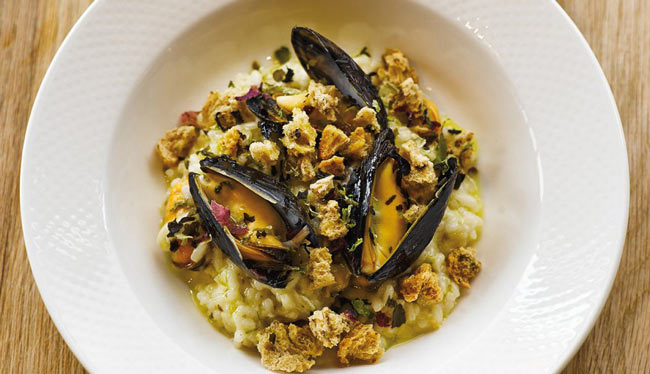Mussel, seaweed and lime risotto
Ease into cooking with seaweed with this seashore risotto dish from Tom Brown of Outlaw's at St Enodoc

This seashore dish from Tom Brown of Outlaw’s at St Enodoc Hotel makes the perfect dinner party starter
Serves 6
You will need
For the risotto:
-
- Unsalted butter 25g
- Onion 1 small
- Aged carnaroli risotto rice 200g
- Vegetable stock 1½ litres
- Mussels 400g, live, cleaned and de-bearded
- Salt for seasoning
- Rapeseed oil for dressing
For the seaweed and lime butter:
- Unsalted butter 100g, softened
- Dried seaweed 2 tbsp – dulse, sea greens and nori
- Garlic 1 clove, finely chopped
- Lime 1, zest and juice
- First make the seaweed and lime butter. Mix the butter, seaweed, garlic and lime until well incorporated. This can be made in advance, wrapped tightly in clingfilm and kept refrigerated until required.
- To make the risotto, first heat the vegetable stock and keep on a low heat. Melt the butter in a large wide pan and sweat the onion until soft.
- Add the risotto rice and cook on a medium heat while stirring until the grains become translucent. Add a ladle of stock to the pan and stir the rice allowing the grains to cook and absorb the liquid. Keep adding stock and stirring one ladle at a time for 16 minutes or until the rice is fluffy and almost cooked. The grains should still have a small amount of resistance when you bite into them, but not be chalky.
- Add the mussels and another ladle of stock and continue to stir. The mussels will slowly open up as they cook. Once all the mussels are open remove the pan from the heat and add the seaweed butter. Continue to stir for 2 minutes, adding more stock if required.
- Serve the risotto with a little sprinkle of seaweed, some fresh lime zest and a drizzle of cold pressed rapeseed oil.
Supported by
You will need
You will need
For the risotto:
-
- Unsalted butter 25g
- Onion 1 small
- Aged carnaroli risotto rice 200g
- Vegetable stock 1½ litres
- Mussels 400g, live, cleaned and de-bearded
- Salt for seasoning
- Rapeseed oil for dressing
For the seaweed and lime butter:
- Unsalted butter 100g, softened
- Dried seaweed 2 tbsp – dulse, sea greens and nori
- Garlic 1 clove, finely chopped
- Lime 1, zest and juice
Method
- First make the seaweed and lime butter. Mix the butter, seaweed, garlic and lime until well incorporated. This can be made in advance, wrapped tightly in clingfilm and kept refrigerated until required.
- To make the risotto, first heat the vegetable stock and keep on a low heat. Melt the butter in a large wide pan and sweat the onion until soft.
- Add the risotto rice and cook on a medium heat while stirring until the grains become translucent. Add a ladle of stock to the pan and stir the rice allowing the grains to cook and absorb the liquid. Keep adding stock and stirring one ladle at a time for 16 minutes or until the rice is fluffy and almost cooked. The grains should still have a small amount of resistance when you bite into them, but not be chalky.
- Add the mussels and another ladle of stock and continue to stir. The mussels will slowly open up as they cook. Once all the mussels are open remove the pan from the heat and add the seaweed butter. Continue to stir for 2 minutes, adding more stock if required.
- Serve the risotto with a little sprinkle of seaweed, some fresh lime zest and a drizzle of cold pressed rapeseed oil.
You may also like
